relativity von einstein albert, Erstausgabe (27 Ergebnisse)
FeedbackSuchfilter
Produktart
- Alle Product Types
- Bücher (27)
- Magazine & Zeitschriften (Keine weiteren Ergebnisse entsprechen dieser Verfeinerung)
- Comics (Keine weiteren Ergebnisse entsprechen dieser Verfeinerung)
- Noten (Keine weiteren Ergebnisse entsprechen dieser Verfeinerung)
- Kunst, Grafik & Poster (Keine weiteren Ergebnisse entsprechen dieser Verfeinerung)
- Fotografien (Keine weiteren Ergebnisse entsprechen dieser Verfeinerung)
- Karten (Keine weiteren Ergebnisse entsprechen dieser Verfeinerung)
- Manuskripte & Papierantiquitäten (Keine weiteren Ergebnisse entsprechen dieser Verfeinerung)
Zustand
- Alle
- Neu (Keine weiteren Ergebnisse entsprechen dieser Verfeinerung)
- Antiquarisch (27)
Einband
Weitere Eigenschaften
Sprache (2)
Gratisversand
Land des Verkäufers
Verkäuferbewertung
-
Relativity - The Special and The General Theory(Routledge Classics)
Anbieter: BooksRun, Philadelphia, PA, USA
Erstausgabe
EUR 7,13
Währung umrechnenKostenlos für den Versand innerhalb von/der USAAnzahl: 1 verfügbar
In den WarenkorbPaperback. Zustand: Fair. 1st. Ship within 24hrs. Satisfaction 100% guaranteed. APO/FPO addresses supported.
-
The Meaning of Relativity. Including the Relativistic Theory of the Non-Symmetric Field [fifth edition]
Verlag: Princeton, Princeton University Press, 1974
ISBN 10: 0691023522 ISBN 13: 9780691023526
Sprache: Englisch
Anbieter: Pallas Books Antiquarian Booksellers, Leiden, Niederlande
Erstausgabe
EUR 5,00
Währung umrechnenEUR 26,00 für den Versand von Niederlande nach USAAnzahl: 1 verfügbar
In den Warenkorbpaperbound, 8vo 169 pp. The Stafford Little Lecturesof Princeton University Press, May 1921; first edition was published in 1922 (Methuen); very good condition (almost unused).
-
RELATIVITY The Special and the General Theory
Verlag: Folio Society, 2004, 2004
Anbieter: Rothwell & Dunworth (ABA, ILAB), Dulverton, Vereinigtes Königreich
Erstausgabe
EUR 16,90
Währung umrechnenEUR 11,72 für den Versand von Vereinigtes Königreich nach USAAnzahl: 1 verfügbar
In den Warenkorb1st printing. 8vo. Original silver lettered pictorial cloth (Fine), slipcase (Fine). Pp. xxii + 201, illus with b&w frontispiece (no inscriptions).
-
Relativity. A Richer Truth
Verlag: Jonathan Cape, London, 1951
Anbieter: Michael Treloar Booksellers ANZAAB/ILAB, Adelaide, SA, Australien
Erstausgabe
EUR 31,88
Währung umrechnenEUR 16,71 für den Versand von Australien nach USAAnzahl: 1 verfügbar
In den WarenkorbHardcover. Zustand: Very Good. First Edition. London, Jonathan Cape, 1951. Octavo, 124 pages. Cloth slightly rubbed and marked; bookplate on front pastedown; text block lightly tanned; an excellent copy. With a foreword by Albert Einstein entitled 'The Laws of Science and the Laws of Ethics'.
-
Relativity; The Special and the General Theory
Verlag: The Folio Society NONE, London
Anbieter: Spafford Books (ABAC / ILAB), Regina, SK, Kanada
Erstausgabe
EUR 39,22
Währung umrechnenEUR 17,59 für den Versand von Kanada nach USAAnzahl: 1 verfügbar
In den Warenkorb[NONE] 2004. (hardcover) Fine. xxii, 201pp. 8vo. The definitive guide to one of the most important discoveries in modern science. First Folio printing. Printed boards. Housed in plain, sturdy, black slipcase, as issued. Slip case shows light markings, not particularly noticeable, but warrant mention. Fine copy in near fine to fine slipcase. Authorized Translation by Robert W. Lawson. Introduced by Roger Penrose.
-
Sidelights on Relativity. I. Ether and Relativity. II. Geometry and Experience. Translated by G. B. Jeffery, D.Sc., and W. Perrett, Ph. D.
Verlag: London: Methuen & Co.Ltd, 1922,, 1922
Anbieter: Harteveld Rare Books Ltd., Fribourg, Schweiz
Erstausgabe
EUR 188,54
Währung umrechnenEUR 20,00 für den Versand von Schweiz nach USAAnzahl: 1 verfügbar
In den Warenkorbsm. in-8vo, 2 leaves (halftitle & titlepage) + 56 p. + 2 leaves + 8 p. publicity on diff. paper, printed on heavy paper, slightly yellowed, Ex-Libris ?Edward Wilder Playfair?, full cloth publisher?s binding, blind-stamped title to front, gilt title to spine, spine sunned. This two lectures were delivered on May 5th, 1920, in the University of Leyden. Its importance was immediately recognized and it was translated into Italian, French, English, Polish, Russian and Hungarian in quick succession.Please notify before visiting to see a book. Prices are excl. VAT/TVA (only Switzerland) & postage. for the first ed. in German cf. Weil 111; Schlipp-Shields n° 131; Alicke 97.
-
Relativity: The Special and The General Theory
Verlag: Methuen & Co. Ltd., London, 1920
Anbieter: PsychoBabel & Skoob Books, Didcot, Vereinigtes Königreich
Erstausgabe
EUR 235,37
Währung umrechnenEUR 11,13 für den Versand von Vereinigtes Königreich nach USAAnzahl: 1 verfügbar
In den WarenkorbHardcover. Zustand: Good. Zustand des Schutzumschlags: No Dust Jacket. Second Edition. Second edition hardcover with embossed front board, no dust jacket, in good condition for its age. Previously owned by a relative of an Oxford teacher, whose name is penned to FEP. A few small marks on the boards. Edges, corners and spine ends are bumped and rubbed. Page block is tanned and blemished. Pastedowns and endpapers are foxed, with spots of foxing also noted on a few of the pages, which are otherwise clear, and binding is sound. LW. Used.
-
RELATIVITY. The special and the General Theory. A popular exposition. Translated by Robert W. Lawson. D.Sc.
Verlag: Methuen & Co. Ltd. London. 1920, 1920
Anbieter: Paul Foster. - ABA & PBFA Member., London, Vereinigtes Königreich
Erstausgabe
EUR 1.750,21
Währung umrechnenEUR 13,01 für den Versand von Vereinigtes Königreich nach USAAnzahl: 1 verfügbar
In den WarenkorbHardcover. Zustand: Fine. 1st Edition. FIRST ENGLISH EDITION. 1st printing. 8vo. (7.6 x 5.1 inches). Portrait frontis and five line diagrams within the text. Complete with the 8pp publishers adverts at back of book. Overall a clean, bright copy in recent fine binding of full red morocco. Spine with raised bands, compartments ruled, decorated and lettered in gilt. Single gilt ruled border on boards. Top edge gilt, others untrimmed with rough edges. ------ This important translation, apart from being the first English edition, also contains new text written by Einstein specially for this edition-- Appendix III, The Experimental Confirmation of the General Theory of Relativity.
-
The Evolution of Physics: The Growth of Ideas from Early Concepts to Relativity and Quanta.
Verlag: Cambridge University Press, Cambridge, 1938
Anbieter: Raptis Rare Books, Palm Beach, FL, USA
Erstausgabe Signiert
EUR 27.171,56
Währung umrechnenKostenlos für den Versand innerhalb von/der USAAnzahl: 1 verfügbar
In den WarenkorbFirst edition of this classic work, which traces the development of ideas in physics. Octavo, original blue cloth. Presentation copy, inscribed by the author in the year of publication on the second free endpaper, "For David Stern Albert Einstein 1938." Fine in a near dust jacket with a few small closed tears. Trade editions signed by Einstein are scarce. Upon publication The Saturday Review of Literature praised Evolution of Physics as "masterly Einstein and Infeld's book should do much to spread an understanding and appreciation one of the great dramas in the evolution of human thought.".
-
The Evolution of Physics: The Growth of Ideas from Early Concepts to Relativity and Quanta.
Verlag: Simon and Schuster, New York, 1951
Anbieter: Raptis Rare Books, Palm Beach, FL, USA
Erstausgabe Signiert
EUR 18.114,37
Währung umrechnenKostenlos für den Versand innerhalb von/der USAAnzahl: 1 verfügbar
In den WarenkorbLater printingÂof this classic work, which traces the development of ideas in physics. Octavo, original blue cloth. Boldly signed by both authors on the front free endpaper, "A. Einstein. 53" and "L. Infeld 1958." Near fine in a very good dust jacket. We have never seen another example signed by both authors. Rare and desirable. Upon publication The Saturday Review of Literature praised Evolution of Physics as "masterly Einstein and Infeld's book should do much to spread an understanding and appreciation one of the great dramas in the evolution of human thought.".
-
Relativity: The Special & the General Theory. A Popular Exposition
Verlag: Methuen & Co, London, 1920
Anbieter: Attic Books (ABAC, ILAB), London, ON, Kanada
Erstausgabe
EUR 1.358,58
Währung umrechnenEUR 7,25 für den Versand von Kanada nach USAAnzahl: 1 verfügbar
In den WarenkorbHardcover. Zustand: Good. First UK Edition. xiii, [3], 138, [2], 8 p. 20 cm. 5 diagrams and frontispiece portrait of the author. Red cloth with blank impressing on front, black print on spine. Some soiling to covers, corners bumped, spine faded, small tears in spine head. Front pastedown has bookplate for Brenda Mary O'Keefe and small chip to edge. Offsetting to free endpapers. Front hinge cracking internally. A few stains within. 8 p. of Methuen publications listed at rear. First edition of the authorized translation into English of the "popular exposition" of Einstein's theory of relativity. Includes third appendix on "The Experimental Confirmation of the General Theory of Relativity," written by Einstein specially for this edition at the request of the translator. First published in German in 1916, "Relativity" gives readers an insight into the thought processes of one of the greatest minds of the 20th century.
-
Relativity: The Special And General Theory.
Verlag: Methuen and Co, London, 1920
Anbieter: Raptis Rare Books, Palm Beach, FL, USA
Erstausgabe
EUR 11.321,48
Währung umrechnenKostenlos für den Versand innerhalb von/der USAAnzahl: 1 verfügbar
In den WarenkorbFirst edition of the scientist's ground breaking work. Octavo, original red cloth, frontispiece of the author and with five diagrams. Near fine in the rare original dust jacket with loss of section at rear. Translated by Robert W. Lawson. Scarce in the original dust jacket. Housed in a custom half morocco clamshell box by the Harcourt Bindery. It can hardly be disputed that the theories put forth in this book are among the most important in the history of modern science. "The imprint of Einstein's work on the different areas of physical science is so large and varied," writes Gerald Holton in a recent assessment, "that a scientist who tries to trace it would be hard put to know where to start" (Simmons, The Scientific 100).
-
The Evolution of Physics; The Growth of Ideas from Early Concepts to Relativity and Quanta
Verlag: Simon and Schuster, New York, 1938
Anbieter: Evening Star Books, ABAA/ILAB, Madison, WI, USA
Erstausgabe
EUR 647,59
Währung umrechnenEUR 5,72 für den Versand innerhalb von/der USAAnzahl: 1 verfügbar
In den WarenkorbHardcover. Zustand: Very Good+. Zustand des Schutzumschlags: Good+. First American edition. 8vo. [2], v-vi, [2], ix-x, [2], 3-319, [5] pp. Blue cloth with gold lettering on the spine and a gold decoration on the front board; navy topstain. Price of $2.50 on the front flap of the dust jacket. Illustrated by three plates and several in-text diagrams. Includes a business reply card from Simon and Schuster, asking the reader to submit their comments on the book. Boni 235. Christie's The History of Quantum Physics and the Theory of Relativity: The Harvey Plotnick Library, 101. A scientific history for a casual reader, intended to explain the history of the evolution of famous theories in physics. Einstein and Infeld begin with the "Mechanical View" of the physical universe, the work done by Galileo and Newton, and the subsequent challenges to their work by modern physicists. The authors devote a section to the decline of the mechanical view, and proceed to explain their work on Relativity and Quanta. Einstein was famous for writing books intended to educate the public on his work and on the history of science. This volume is an example of his noble goal in making physics accessible to all readers. A Very Good+ book with a name and date of 1938 on the free front endpaper and toning to the endpapers and pastedowns; dust jacket is Good or better with notable edge wear, resulting in minor loss to the spine panel and folds.
-
Relativity the Special & the General Theory A Popular Exposition
Verlag: the Ryerson Press.; Methuen & Co. Edition., Toronto; London, 1920
Anbieter: Alexandre Antique Prints, Maps & Books, Toronto, ON, Kanada
Erstausgabe
EUR 860,43
Währung umrechnenEUR 5,28 für den Versand von Kanada nach USAAnzahl: 1 verfügbar
In den WarenkorbEdition : First Canadian Edition., after the first London., Contemporary full red cloth, title on flat spine, debossed stamped title on the upper board, lacks the dust jacket. , Albert Einstein (1879 ? 1955) was a German-born theoretical physicist who developed the theory of relativity, one of the two pillars of modern physics (alongside quantum mechanics). His work is also known for its influence on the philosophy of science. He is best known to the general public for his mass?energy equivalence formula which has been dubbed "the world's most famous equation". He received the 1921 Nobel Prize in Physics "for his services to theoretical physics, and especially for his discovery of the law of the photoelectric effect", a pivotal step in the development of quantum theory., Size : Octavo (8vo.), Illustrated with five diagrams and numerous in text mathematical equations. A foundation work in physics and astronomy. A near fine example, text and illustrations clean and crisp.
-
Relativity; The Special & the General Theory; A Popular Exposition
Verlag: Methuen & Co. Ltd., London
Anbieter: Spafford Books (ABAC / ILAB), Regina, SK, Kanada
Erstausgabe
EUR 1.437,97
Währung umrechnenEUR 17,59 für den Versand von Kanada nach USAAnzahl: 1 verfügbar
In den Warenkorb1920, 1st English edition. (Leatherbound) Near fine. xiii, [3], 138pp, [2], 8pp. 12mo. Rebound in striking red leather; spine with raised bands ruled in gilt, each compartment with decorative device in gilt, author and title compartments lettered in gilt; top and bottom boards with simple single-rule border in gilt. Binding tight; seemingly scarcely opened. Top-edge gilt. Foxing to fore-edge and bottom-edge. Foxing to half-title; else with only occasional spot of foxing at fore-margin and bottom-margin, corresponding from edge. Internally remarkably clean. Portrait frontispiece. Diagrams, formulae. With original 8pp of adverts bound at rear. An exceedingly collectible copy of this seminal work; truly, the importance of this work cannot be overstated. In specific regards to this edition, in addition to being the First English translation of Einstein's paradigm shifting work, it includes new text which was written by Einstein specifically for this edition at the request of the translator (Appendix III: "The Experimental Confirmation of the General Theory of Relativity"). The fourth appendix, "The Structure of Space according to the General Theory of Relativity," didn't appear in an English edition until the 14th edition (1946). [Relativity, 100th Anniversary Edition, Princeton UP, p.xx].
-
Einstein's Theory of Relativity.
Verlag: Methuen & Company, London, 1924
Anbieter: Raptis Rare Books, Palm Beach, FL, USA
Erstausgabe Signiert
EUR 11.321,48
Währung umrechnenKostenlos für den Versand innerhalb von/der USAAnzahl: 1 verfügbar
In den WarenkorbFirst edition of this classic account of Born's analysis and interpretation of Einstein's theory of relativity. Octavo, original cloth, frontispiece of Einstein. Signed by Max Born on the verso of the frontispiece. Translated by Henry L. Brose. Very good in a very good dust jacket. Housed in a custom half morocco clamshell box. First editions are uncommon, signed examples rare. Einstein's Theory of Relativity is a book in which one great mind explains the work of another great mind in terms comprehensible to the layman is a significant achievement. This is such a book. Max Born was awarded the Nobel Prize in 1954 and was one of the world's great physicists: in this work he analyzes and interprets the theory of Einsteinian relativity. The result is undoubtedly the most lucid and insightful of all the books that have been written to explain the revolutionary theory that marked the end of the classical and the beginning of the modern era of physics. Born follows a quasi-historical method of presentation. The book begins with a review of the classical physics, covering such topics as origins of space and time measurements, geometric axioms, Ptolemaic and Copernican astronomy, concepts of equilibrium and force, laws of motion, inertia, mass, momentum and energy, Newtonian world system (absolute space and absolute time, gravitation, celestial mechanics, centrifugal forces and absolute space), laws of optics (the corpuscular and undulatory theories, speed of light, wave theory, Doppler effect, convection of light by matter), electrodynamics (including magnetic induction, electromagnetic theory of light, electromagnetic ether, electromagnetic laws of moving bodies, electromagnetic mass, and the contraction hypothesis). Born then takes up his exposition of Einstein's special and general theories of relativity, discussing the concept of simultaneity, kinematics, Einstein's mechanics and dynamics, relativity of arbitrary motions, the principle of equivalence, the geometry of curved surfaces, and the space-time continuum, among other topics. Born then points out some predictions of the theory of relativity and its implications for cosmology, and indicates what is being sought in the unified field theory. This work steers a middle course between vague popularizations and complex scientific presentations. This is a careful discussion of principles stated in thoroughly acceptable scientific form, yet in a manner that makes it possible for the reader who has no scientific training to understand it. Only high school algebra has been used in explaining the nature of classical physics and relativity, and simple experiments and diagrams are used to illustrate each step. The layman and the beginning student in physics will find this an immensely valuable and usable introduction to relativity.
-
Relativity The Special And General Theory. Translated By Robert W. Lawson.
Verlag: New York: Henry Holt And Company, 1920., 1920
Anbieter: D & E LAKE LTD. (ABAC/ILAB), Toronto, ON, Kanada
Erstausgabe
EUR 1.508,02
Währung umrechnenEUR 13,19 für den Versand von Kanada nach USAAnzahl: 1 verfügbar
In den WarenkorbHardcover. Zustand: Very Good. 1st Edition. 8vo. pp. xiii, 168. frontis. portrait. biblio. index. cloth (spine ends just beginning to fray). Very good copy. First American Edition. The English translation contains an additional chapter, 'Appendix III The Experimental Confirmation of the General Theory of Relativity.' See Printing and the Mind of Man 408.
-
The Meaning of Relativity
Verlag: Princeton University Press, Princeton, 1923
Anbieter: Burnside Rare Books, ABAA, Portland, OR, USA
Erstausgabe
EUR 3.170,01
Währung umrechnenKostenlos für den Versand innerhalb von/der USAAnzahl: 1 verfügbar
In den WarenkorbHardcover. Zustand: Very Good. First Edition. First American edition, first printing. Near Fine with slight fade to spine cloth, gilt stamping very sharp on front cover. Previous owner bookplate to front paste down with patch of abrasion at nearby gutter. Pages toned, with several hinges just slightly over-opened. In a Very Good dust jacket with a large chip and tear at the top of the spine, toning to spine and edges, and several small edge tears. A very nice copy in the scarce dust jacket.
-
On the Motion of Particles in General Relativity Theory. Reprinted from the Canadian Journal of Mathematics. Vol. 1, No. 3, 1949.
Verlag: [Ottowa: Canadian Mathematical Society,] 1949, 1949
Anbieter: Peter Harrington. ABA/ ILAB., London, Vereinigtes Königreich
Erstausgabe
EUR 1.810,56
Währung umrechnenEUR 16,41 für den Versand von Vereinigtes Königreich nach USAAnzahl: 1 verfügbar
In den WarenkorbFirst edition, offprint issue. Einstein and Infeld demonstrate that "field equations alone suffice as a basis for solving the problem of motion in general relativistic theory, since the Einstein equations not only determine how particles must respond to gravitational forces, but also contain the information necessary to describe those forces" (Calaprice, p. 323). Boni 259; Weil 223. Alice Calaprice, An Einstein Encyclopedia, 2015. Octavo, pp. 34. Original orange wrappers, wire-stitched as issued, front cover lettered in black. Front wrapper lightly marked: a near-fine copy.
-
The Theory of Relativity. The Special & the General Theory. A Popular Exposition. Authorised Translation by Robert W. Lawson. With Five Diagrams and a Portrait of the Author.
Verlag: London: Methuen & Co. Ltd, 1920, 1920
Anbieter: Peter Harrington. ABA/ ILAB., London, Vereinigtes Königreich
Erstausgabe
EUR 1.207,04
Währung umrechnenEUR 16,41 für den Versand von Vereinigtes Königreich nach USAAnzahl: 1 verfügbar
In den WarenkorbFirst edition in English, first impression, marking the first appearance of any of Einstein's works in English and including a new chapter written by Einstein for this edition. It was first published in German in 1916 and is here translated from the third edition of 1918. Methuen urged Lawson to make the translation "as intelligible as possible to the ordinary man. There is complete ignorance in the public mind as to what Relativity means. A good many people seem to think that the book deals with the relations between the sexes" (Buchwald, Sauer, & Kennefick, p. 326). The additional chapter (Appendix III) for this edition was written by Einstein in only a few hours, after Lawson suggested the book would be more accessible if its author could provide a proof of the general theory. Weil 90A. Buchwald, Sauer, & Kennefick, eds, The Collected Papers of Albert Einstein Volume 9: The Berlin Years: Correspondence January 1919-April 1920, 2004. Octavo. Portrait frontispiece of author by Hermann Struck, numerous diagrams within text. With 8 pp. of publisher's advertisements at rear. Original red vertical-grain cloth, spine lettered in gilt, front cover lettered in blind. With ownership inscription of Alfred Walter Hunter (1883-1930), Glasgow writer and lawyer, to front free endpaper. Cloth a little marked and cockled, wear to corners and spine ends, spine toned, damp stain to outer corners of front board following through to preliminaries, including frontispiece: a very good copy.
-
Relativity. The Special and the General Theory. A Popular Exposition. Authorised Translation by Robert W. Lawson. With five Diagrams and a Portrait of the Author.
Verlag: London: Methuen & Co. Ltd, 1920, 1920
Anbieter: Peter Harrington. ABA/ ILAB., London, Vereinigtes Königreich
Erstausgabe
EUR 3.621,12
Währung umrechnenEUR 16,41 für den Versand von Vereinigtes Königreich nach USAAnzahl: 1 verfügbar
In den WarenkorbFirst edition in English, marking the first appearance of any of Einstein's works in English and including a new chapter written by Einstein for this edition. It was first published in German in 1916 and is here translated from the third edition of 1918. Methuen urged Lawson to make the translation "as intelligible as possible to the ordinary man. There is complete ignorance in the public mind as to what Relativity means. A good many people seem to think that the book deals with the relations between the sexes" (Buchwald, Sauer, & Kennefick, p. 326). The additional chapter (Appendix III) was written by Einstein in only a few hours, after Lawson suggested the book would be more accessible if its author could provide a proof of the general theory. Weil 90A. Buchwald, Sauer, & Kennefick, eds, The Collected Papers of Albert Einstein Volume 9: The Berlin Years: Correspondence January 1919-April 1920, 2004. Octavo (180 x 113 mm). Portrait frontispiece of author by Hermann Struck, diagrams in text. With 8 pp. of publisher's advertisements at rear. Finely bound by the Chelsea Bindery in red morocco, titles to spine gilt, twin rule to turn-ins gilt, blue endpapers, gilt edges. Couple of trivial spots to title page; an excellent copy.
-
Relativity: The Special and General Theory
Verlag: Henry Holt & Company, New York, 1920
Anbieter: Burnside Rare Books, ABAA, Portland, OR, USA
Erstausgabe
EUR 1.358,58
Währung umrechnenKostenlos für den Versand innerhalb von/der USAAnzahl: 1 verfügbar
In den WarenkorbZustand: Very Good. First Edition. First American edition, first printing. Bound in publisher's original dark blue cloth boards lettered in gilt with upper board ruled in blind. Very Good with light wear and soiling to cloth, spine darkened, slightly worn at the ends and with gilt rubbed. Former owner name and inkless emboss to front free endpaper, pages toned and with a faint odor of cigar smoke. A nice copy of the groundbreaking first appearance of Einstein's theories for a general American audience.
-
Sidelights on Relativity.
Verlag: Methuen, London., 1922
Anbieter: Peter Ellis, Bookseller, ABA, ILAB, London, Vereinigtes Königreich
Erstausgabe
EUR 935,46
Währung umrechnenEUR 17,58 für den Versand von Vereinigtes Königreich nach USAAnzahl: 1 verfügbar
In den WarenkorbFirst English edition. Translated by G.B. Jeffery and W. Perrett. Octavo. pp [iv], 56, 8 adverts. Contains two addresses, "Ether and Relativity" and "Geometry and Experience'. Spine and cover edges a little faded. Lower corners slightly bruised. Endpapers and edges spotted. Very good in the scarce and fragile dustwrapper which is good, chipped at edges, a bit rubbed, starting to split at the joints and missing a piece of about an inch in the centre of the spine.
-
Über die vom Relativitätsprincip geforderte Trägheit der Energie. (On the Inertia of Energy Required by the Relativity Principle).
Anbieter: Herman H. J. Lynge & Søn ILAB-ABF, Copenhagen, Dänemark
Erstausgabe
EUR 1.862,30
Währung umrechnenKostenlos für den Versand von Dänemark nach USAAnzahl: 1 verfügbar
In den WarenkorbLeibzig, Johann Ambrosius Barth, 1907. 8vo. Contemp. hcalf. Spine gilt and with gilt lettering. Slightly rubbed and light wear to spineends. In "Annalen der Physik", Vierte Folge, Band 23. VIII,1000 pp. a. 4 plates. (The entire volume offered). Einstein's paper: pp.371-384. Stamps on titlepage (Allgemeine Electricitäts-Gesellschaft a. AEG Forschungsinstitut). Internally clean. First edition of the first explicit statement of Einstein's energy-mass equation E=mc2.Nearly all descriptions of Einstein's scientific work state that the mass-energy equivalence E=mc2 was first formulated in Einstein's 1907 review paper 'Über das Relativitätsprinzip und die aus demselben gezogenen.' published in 'Jahrbuch der Radioaktivität und Elektronik' (see Weil no. 21 and Dictionary of Scientific Biography, vol. 4 pp.323 for examples). However, in his paper 'Über die von Relativitätsprincip geforderte Trägheit der Energie' [the offered paper] which predates the former mentioned by six months, Einstein gave a clear statement of the mass-energy equivalence E=mc2. See Lanczos: The Einstein Decade, pp.149-150 and 153 as well as Volume 2 of 'The Collected Papers of Albert Einstein' pp. 428.Einstein's first paper regarding the relation E=mc2 is his fourth 1905 paper, 'Ist die Trägheit eines Körpers von seinem Energieinhalt abhängig?'. In this short paper Einstein showed that a body releasing the energy E in the form of radiation will have its mass decreased by E/c2, and concluded that the mass of a body is a measure of its energy content, e.g., that all energy has mass. The next time Einstein returns to the subject is in his 1906 paper 'Das Prinzip von der Erhaltung der Schwerpunkts Bewegung und die Trägheit der Energie.'. Here Einstein concluded that one must either ascribe the inertial mass E/c2 to any form of energy E or else give up the fundamental law mechanics regarding conservation of the motion of the center of gravity. Then finally in the 1907 paper 'Über die von Relativitätsprincip geforderte Trägheit der Energie.' [the offered paper] Einstein makes the decisive step of assuming that all mass has energy. On page 382 Einstein considers the total energy of a moving mass point as the sum of its kinetic energy and its rest energy. In classical mechanics it is most convenient to set the second term to zero but in relativistic mechanics one obtains the simplest expression by setting the rest energy equal to mc2. Einstein then continues to show that this stipulation cannot lead to a contradiction in any relativistic argument. In a footnote on page 382 Einstein states for the first time the equation E=mc2 and mentions that this equation is the expression of the principle of the equivalence of mass and energy - see Volume 2 of 'The Collected Papers of Albert Einstein' pp. 428.The volume contains another paper by Einstein "Bemerkungen zu der Notiz von Hrn. Paul Ehrenfest: "Die Translation deformierbarer Elektronen und der Flächensatz", pp.206-208. - Weil No. 18. Further with 2 importent papers by Max v. Laue.Collected Works, Doc. 45. Weil 19. Boni 19.
-
Über die vom Relativitätsprincip geforderte Trägheit der Energie. (On the Inertia of Energy Required by the Relativity Principle).
Anbieter: Herman H. J. Lynge & Søn ILAB-ABF, Copenhagen, Dänemark
Erstausgabe
EUR 2.069,22
Währung umrechnenKostenlos für den Versand von Dänemark nach USAAnzahl: 1 verfügbar
In den WarenkorbLeibzig, Johann Ambrosius Barth, 1907. 8vo. Contemp. hcalf. Spine gilt. Title-and tomelabels with gilt lettering. Slightly rubbed. In "Annalen der Physik", Vierte Folge, Band 23. VIII,1000 pp. a. 4 plates. (The entire volume offered). Einstein's paper: pp.371-384. A small stamp on titlepage (Gmelin.Institut.). Internally clean and fine. First edition of the first explicit statement of Einstein's energy-mass equation E=mc2.Nearly all descriptions of Einstein's scientific work state that the mass-energy equivalence E=mc2 was first formulated in Einstein's 1907 review paper 'Über das Relativitätsprinzip und die aus demselben gezogenen.' published in 'Jahrbuch der Radioaktivität und Elektronik' (see Weil no. 21 and Dictionary of Scientific Biography, vol. 4 pp.323 for examples). However, in his paper 'Über die von Relativitätsprincip geforderte Trägheit der Energie' [the offered paper] which predates the former mentioned by six months, Einstein gave a clear statement of the mass-energy equivalence E=mc2. See Lanczos: The Einstein Decade, pp.149-150 and 153 as well as Volume 2 of 'The Collected Papers of Albert Einstein' pp. 428.Einstein's first paper regarding the relation E=mc2 is his fourth 1905 paper, 'Ist die Trägheit eines Körpers von seinem Energieinhalt abhängig?'. In this short paper Einstein showed that a body releasing the energy E in the form of radiation will have its mass decreased by E/c2, and concluded that the mass of a body is a measure of its energy content, e.g., that all energy has mass. The next time Einstein returns to the subject is in his 1906 paper 'Das Prinzip von der Erhaltung der Schwerpunkts Bewegung und die Trägheit der Energie.'. Here Einstein concluded that one must either ascribe the inertial mass E/c2 to any form of energy E or else give up the fundamental law mechanics regarding conservation of the motion of the center of gravity. Then finally in the 1907 paper 'Über die von Relativitätsprincip geforderte Trägheit der Energie.' [the offered paper] Einstein makes the decisive step of assuming that all mass has energy. On page 382 Einstein considers the total energy of a moving mass point as the sum of its kinetic energy and its rest energy. In classical mechanics it is most convenient to set the second term to zero but in relativistic mechanics one obtains the simplest expression by setting the rest energy equal to mc2. Einstein then continues to show that this stipulation cannot lead to a contradiction in any relativistic argument. In a footnote on page 382 Einstein states for the first time the equation E=mc2 and mentions that this equation is the expression of the principle of the equivalence of mass and energy - see Volume 2 of 'The Collected Papers of Albert Einstein' pp. 428.The volume contains another paper by Einstein "Bemerkungen zu der Notiz von Hrn. Paul Ehrenfest: "Die Translation deformierbarer Elektronen und der Flächensatz", pp.206-208. - Weil No. 18.Collected Works, Doc. 45. Weil 19. Boni 19.
-
APPENDIX FOR THE SECOND EDITION [of The Meaning of Relativity] + APPENDIX II. GENERALIZED THEORY OF GRAVITATION. - [ORIGINAL PROOF-COPY]
Anbieter: Herman H. J. Lynge & Søn ILAB-ABF, Copenhagen, Dänemark
Erstausgabe
EUR 1.931,27
Währung umrechnenKostenlos für den Versand von Dänemark nach USAAnzahl: 1 verfügbar
In den Warenkorb[1950]. 8vo. Original proof-copy (of the latest stage, presumably final proof, in the same format as the printed version and with no corrections), printed on rectos and versos. Stapled twice in left margin. A few marginal creases. A (proof-) number to upper left corner in red ink (297). Pp. 109-148 + tipped-in errata slip at p. 147. Very rare original proof-copy of the two highly important appendices for Einstein's "The Meaning of Relativity", third edition, 1950, the second appendix being one of the most important pieces Einstein ever wrote, namely the appendix "in which he described his most recent work on unification" (Pais), and the work which was hailed by The New York Times under the heading "New Einstein theory gives a master key to the universe". The first appendix, which appeared for the second edition of the work, remained unchanged throughout the history of "the Meaning of Relativity" and was written because "Since the first edition of this little book some advances have been made in the theory of relativity. [.] The first step forward is the conclusive demonstration of the existence of the red shift of the spectral lines by the (negative) gravitational potential of the place of origin" [.] A second step forward, which will be mentioned briefly, concerns the law of motion of a gravitating body." [.] A third step forward, concerning the so-called "cosmologic problem," wiil be considered here in detail." (pp. 109-10). The present 40 pages constitute the final proof-copy of the entire appendices I and II to the Generalized Theory of Gravitation, exactly as they appeared in the third edition (Princeton in 1950). Einstein's "The Meaning of Relativity" was originally published in 1922, on the basis of his "Vier Vorlesungen ueber Relativitetstheorie" given at Princeton in 1921. A second edition, with an appendix (appendix I) appeared in 1945 (several issues and editions of this appeared also), and in 1949 the third edition, with the seminal Appendix II printed for the first time, appears (also appeared in 1950, in Princeton). In 1950 a revised edition of the third edition appears, having Appendix II slightly revised, and in 1953 the heavily revised fourth edition appears. THIS IS THE PROOF-COPY OF APPENDICES I AND II FOR THE "THIRD EDITION, INCLUDING THE GENERALIZED THEORY OF GRAVITATION" (PRINCETON, 1950). The main focus of the work throughout all these editions of the work since 1949 is Appendix II, which deals with Einstein's main interest, the generalization of the Gravitation Theory, which was to unite the general theory of relativity with electromagnetism, recovering an approximation for quantum theory, and presenting us with a theory to explain the universe as a unified entity, the ultimate goal for the greatest physicist that ever lived. "This was Einstein's ultimate response to the mechanical-electromagnetic crisis in physical theory he had first talked about in the opening of his 1905 light quantum-paper." (Nandor, in D.S.B., p. 330). It was indeed Einstein's aim to provide an explanation of the universe through his unified field theory, although he was well aware that his sort of field theory might not exist. However, even the establishing of the non-existence of it could bring us closer to an explanation than we had ever been before. There is no topic of greater importance to Einstein than his theory of unification. "In 1949 Einstein wrote a new appendix for the third edition of his "The Meaning of Relativity" in which he described his most recent work on unification. It was none of his doing that a page of his manuscript appeared on the front page of "The New York Times" under the heading "New Einstein theory gives a master key to the universe". He refused to see reporters and asked Helen Dukas to relay this message to them: "Come back and see me in twenty years"." (Pais, p. 350).
-
Grundgedanken und Probleme der Relativitätstheorie. (Fundamental ideas and problems of the theory of relativity). Vortrag gehalten an der Nordischen Naturforscherversammlung in Gotenburg den 11 Juli 1923. (Basic ideas and problems of the theory of rel.
Anbieter: Herman H. J. Lynge & Søn ILAB-ABF, Copenhagen, Dänemark
Erstausgabe
EUR 2.069,22
Währung umrechnenKostenlos für den Versand von Dänemark nach USAAnzahl: 1 verfügbar
In den WarenkorbStockholm, Nordstedt & Fils, 1923. Orig. printed wrappers. Offprint from "Les Prix Nobel en 1921-1922". Pp. 1-10. Fine and clean. First edition in the scarce offprint version of Einsteins Nobel lecture. The paper presents the Nobel lecture delivered in Göteborg on July 11, 1923. Because Einstein did not deliver the lecture at the same time as he received the award, it did not concern the prize topic, which was "for his attainments in mathematical physics and especially for his discovery of the law of the photoelectrical effect."In relation to his Nobel Prize, Einstein would have preferred to speak on unified field theory, but he followed Arrhenius proposal "but it is certain that one would be most grateful for a lecture about your relativity theory." On a very hot day in July, Einstein, dressed in a black redingote, addressed an audience of about two thousand in the Jubilee Hall in Göteborg on "basic ideas and problems of the theory of relativity." King Gustav V, who was present, had a pleasant chat with Einstein afterwards. Einstein later gave a second, more technical lecture at Chalmers Technical Institute for about fifty members of the Science Society."(Pais, pp. 504-5).Weil: 135. - Boni: 136.


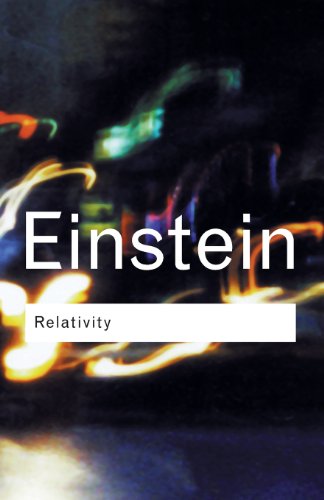
![Beispielbild für The Meaning of Relativity. Including the Relativistic Theory of the Non-Symmetric Field [fifth edition] zum Verkauf von Pallas Books Antiquarian Booksellers](https://pictures.abebooks.com/isbn/9780691023526-de-300.jpg)






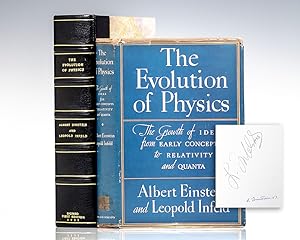

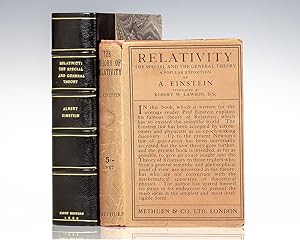
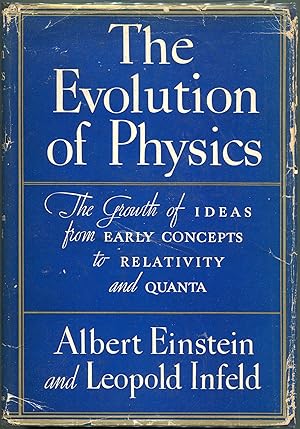
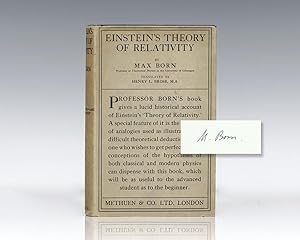
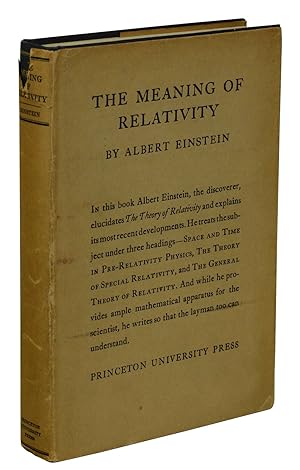



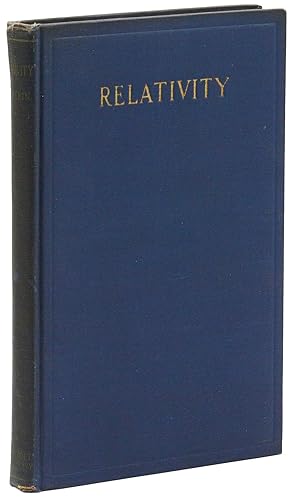
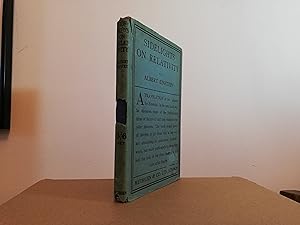
![Bild des Verkäufers für APPENDIX FOR THE SECOND EDITION [of The Meaning of Relativity] + APPENDIX II. GENERALIZED THEORY OF GRAVITATION. - [ORIGINAL PROOF-COPY] zum Verkauf von Herman H. J. Lynge & Søn ILAB-ABF](https://pictures.abebooks.com/inventory/md/md7590144816.jpg)
